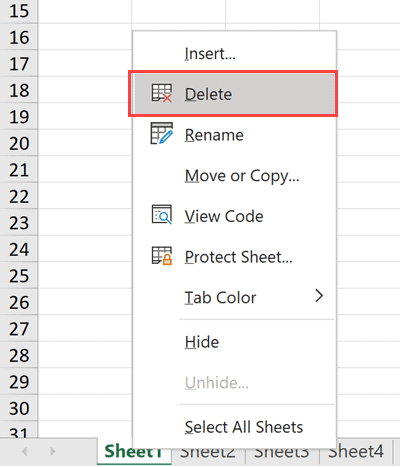3 Easy Steps to Delete Sheets in Excel 2013

Microsoft Excel 2013, like its previous versions, remains a staple tool in many offices due to its extensive data manipulation and analysis capabilities. Among its many features, managing sheets within workbooks is a fundamental task. Here, we'll delve into how to delete sheets in Excel 2013, ensuring your workbook stays organized and manageable.
Step-by-Step Guide to Delete Sheets

Right-Click Method

The most straightforward way to delete sheets in Excel 2013 involves:
- Right-click on the tab of the sheet you wish to delete at the bottom of the Excel window.
- In the context menu that appears, click on ‘Delete’.
- If the sheet contains data, a confirmation dialog will appear; click ‘Delete’ to proceed.
💡 Note: Ensure you really want to delete the sheet as this action cannot be undone unless you immediately use Undo (Ctrl+Z).
Home Tab Method

If you prefer using the Ribbon:
- Go to the ‘Home’ tab on the Ribbon.
- In the ‘Cells’ group, click on ‘Delete’ followed by ‘Delete Sheet’.
- Confirm the deletion if prompted.
Using Shortcut Keys

For those who favor keyboard shortcuts:
- Select the sheet you want to delete.
- Press Alt + E, then L, and hit Enter.
📢 Note: Remember, this method might not work if the sheet is protected or contains protected cells.
How to Delete Multiple Sheets

If you need to remove several sheets:
- Hold down Ctrl to select multiple sheets. (They must be adjacent or you’ll need to select them one by one.)
- Use any of the deletion methods above. If using the right-click, only the first sheet will be selected by default; ensure you hold Ctrl to select additional sheets.
Protecting Sheets from Accidental Deletion

To avoid unintended sheet deletions:
| Lock Sheets | Right-click the tab, select Protect Sheet, and set a password. |
| Restrict Access | Consider using Excel’s workbook protection features to limit who can delete or modify sheets. |

🔒 Note: While this prevents deletions, it can also prevent other edits, so use judiciously.
Summing up, mastering the art of managing sheets in Excel 2013 is essential for efficient document organization. Whether you’re consolidating data, managing projects, or performing financial analyses, understanding these simple deletion methods helps keep your workbooks lean and focused on relevant information.
The techniques provided not only expedite the process of deleting sheets but also ensure you do so safely. From using context menus, ribbon commands, to shortcuts, Excel 2013 has made deleting sheets an accessible task. Moreover, by employing protection features, you can safeguard your workbook from unintended changes, making your Excel experience smoother and more controlled.
How can I undo a sheet deletion?

+
Immediately press Ctrl+Z or select ‘Undo’ from the Quick Access Toolbar. This must be done quickly before you perform another action.
Can I delete a sheet without any warning or confirmation?

+
No, Excel 2013 will always ask for confirmation before deleting a sheet that contains data. This helps prevent accidental data loss.
What happens if I delete a sheet with links?

+
Any external or internal links to the deleted sheet will break, resulting in #REF! errors or other invalid references.
How can I delete sheets with VBA?

+
You can use VBA to automate sheet deletion. Here’s a simple macro: ‘ActiveSheet.Delete’ to delete the currently active sheet.
What does it mean if a sheet can’t be deleted?

+
The sheet might be protected or part of a shared workbook. In such cases, you’ll need to unprotect the sheet or resolve sharing conflicts first.



